The Tibetan mastiff, also called the Tibetan Great Dane, is an amazing and very unusual dog. High growth, a powerful skeleton, thick coat and a look from below give the animal a formidable and impregnable appearance. The breed was bred in Tibet to protect the homes of local residents and livestock, and to this day, the "Tibetans" are happy to serve people as bodyguards and companions. However, this dog is not suitable for everyone, primarily because of its strength and size.
To what size is a mastiff capable of “waving”? What factors influence its growth and development? Read about this and much more in our article.

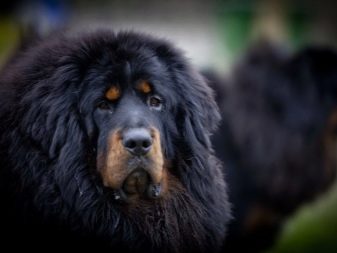
Breed description
To begin with, it is worth introducing you a little with this interesting bear-like dog. “Tibetans” are by their very nature independent. Like many other breeds whose purpose was to graze and protect livestock, these dogs are able to make independent decisions depending on the situation. However, one cannot say that mastiffs are naughty dogs, but, they really feel if a person is not self-confident, and can quickly take a leadership position. That is why the puppy needs to instill a sense of respect for the head of the family and its members from childhood.
The security qualities of the “Tibetans” are at the highest level. Any stranger who appears in the dog’s field of vision is immediately under close surveillance. Because of this feature, only a physically strong person can walk with a “Tibetan”, holding dogs on a short leash, with the obligatory putting on of a muzzle.
A loud sound, a sharp gesture, a quick movement - all this can provoke aggression of this large dog.That is why from an early age it is very important to instill "Tibetan" obedience and discipline.
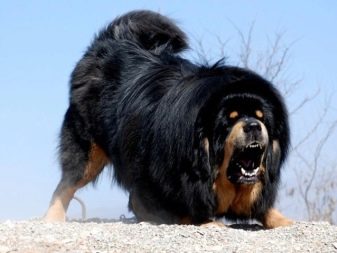
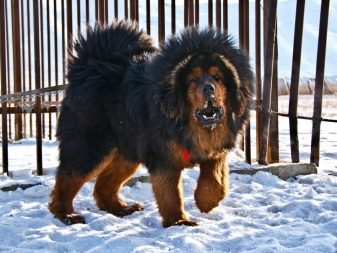
Now let's talk about the appearance of the Tibetan mastiff. A distinctive feature of the representative of the breed is a dense coat with a chic mane. Other parameters:
- large broad head, muscular neck;
- scissor bite or straight, massive muzzle, large nose with a dark lobe;
- the body is large, powerful, muscular, the back is straight, the chest is wide;
- thick coat, the remaining hair is long, rough to the touch;
- wide-set dark brown eyes;
- the ears are triangle-shaped, small in size, hanging;
- high set furry tail;
- powerful smooth legs.
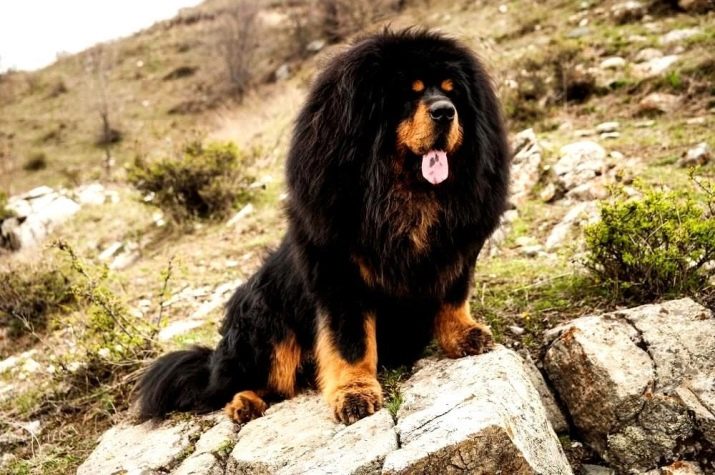
The standard colors of the breed are as follows.
- The black. The main tone of the coat, small yellowish spots are acceptable.
- Tan. The dog itself is black, but there are symmetrical reddish-brown spots - tan marks, which have clear boundaries and are located in certain places.
- Ginger. This refers to a variety of shades: gold, red, sand.
In each of the above colors, the presence of a narrow white "shirt-front" on the breast is permissible.

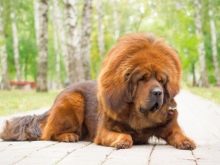
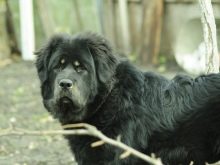
What influences development?
If you decide to purchase a Tibetan mastiff puppy, you should clearly understand that such a dog can live only in a country house. In the apartment, even in the most spacious, the “Tibetan” will be uncomfortable. Walking an animal in urban conditions will also be difficult due to the huge number of “irritants”: car beeps, stray animals, children's screams, cyclists, etc.
As a rule, dogs such as the Tibetan mastiff are not bought spontaneously, but are carefully planned for such an acquisition, pursuing a specific goal: security at home or another facility, grazing. Therefore, the future owner wants to acquire the most promising puppy from the litter.

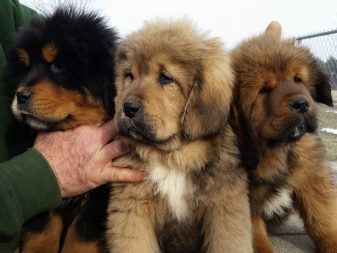
Let's look at the factors that influence the growth and development of a small “Tibetan”.
- First of all, it is, of course, genetics. Even if you follow all the rules of feeding, regular veterinary examinations, performing the necessary physical exercises - if the genes "let us down," you can’t raise a large dog. That is why it is very important to get a puppy only from trusted breeders with a preliminary study of the pedigree of the future pet.
- In second place in importance is the amount of mother's milk received by the puppy in the first days of life. If a baby is malnourished from birth, it will be weaker than its brothers and sisters, respectively, and smaller.
- The third component logically follows - the quality of the mother-bitch’s nutrition. If she received sufficient amounts of vitamin-mineral supplements in the process of carrying offspring, lived in heat, walked for a long time, then it can be said with almost one hundred percent certainty that she will give birth to puppies with excellent initial data. If, on the contrary, the conditions of her detention left much to be desired, then the offspring of such a mother will be weak, with possible developmental pathologies. Saving on a female bitch both during pregnancy and after giving birth is a very bad idea.
- Puppy nutrition after suction period. When babies are weaned and given the first lure, it’s very important to make the right diet. There are 2 ways: feeding "naturalka" or finished feed. If you choose the first way, be prepared for the fact that the puppy will need animal protein (chicken, turkey, beef, eggs, cottage cheese), carbohydrates (buckwheat, rice, vegetables), fats (vegetable oil). When choosing ready-made feeds, give preference to super-premium foods marked giant.
- Physical activity. A Tibetan is a dog that needs sport and training. A mastiff should walk at least 2-3 hours a day, while it is advisable that he not just follow the owner, but run freely, execute commands, overcome obstacles. If you have your own yard - fine, if not - you have to carry your pet to a special area or out of town.
- The disease. They are both congenital and acquired. And if nothing can be done about developmental defects inherited (it is better to refuse to buy such a puppy), then acquired diseases at the first signs of occurrence can and should be treated. Show the animal to the veterinarian, follow all his instructions, and you can grow a large and healthy animal.

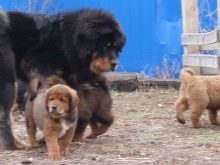
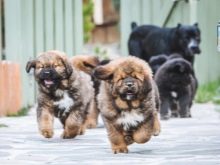
How old are they?
The development of the "Tibetans" is rather slow. Girls grow up to 3 years of age, boys - up to 4 years. At the same time, their puberty also “slows down”: the first mating is permissible no earlier than the female being 2 years old, while in males, individual characteristics (height, weight, etc.) are taken into account. Tibetan mastiffs have a heat only once a year, most often in the winter.
A pair for mating must be selected very competently, because the future characteristics of the offspring and the prospect of puppies as exhibition specimens depend on the transferred set of genes.
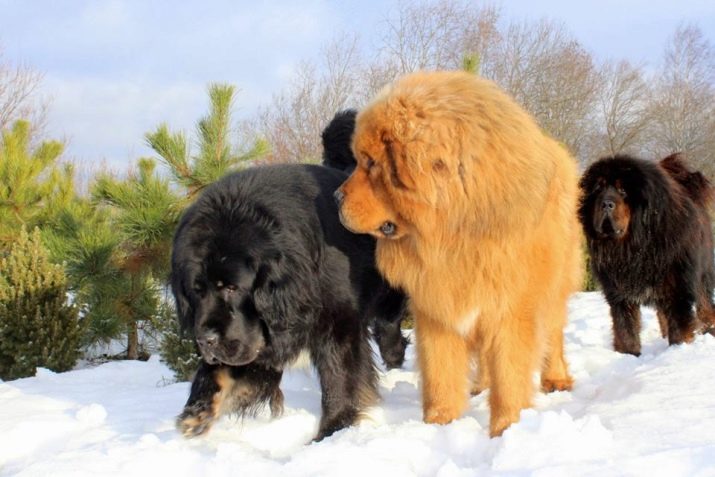
Average parameters depending on gender
"Tibetans" are rightfully considered giants among dogs, although there are breeds and larger. According to the characteristics of the breed, their average dimensions are as follows:
- the average weight of an adult male is about 70 kg, bitches up to 65 kg;
- average height (at the withers): male - 68-71 cm, bitch - 58-62 cm.

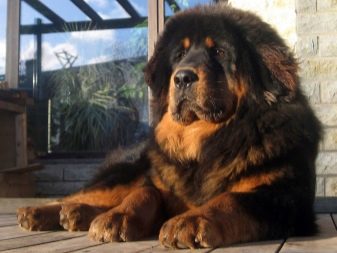
Height and weight of adult dogs
The description of the Tibetan mastiff says that it occupies the sixth line in the rating of the highest dogs in the world. A photo “walks” on the Internet, where a person with difficulty holds a violently tearing dog with dimensions that are not inferior to a brown bear. This, of course, is a fake. The maximum recorded growth achieved by the representative of this breed is 80 cm, and the weight can reach 85-90 kg.
The absolute record holder today is the male Hong Dong, which has reached a weight of 155 kg.
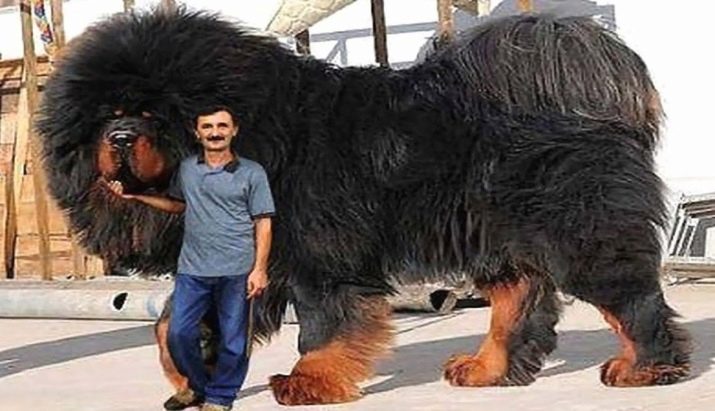
Monthly puppy sizes
So, it's time to find out what the size of Tibetan mastiffs is, depending on their age. “Tibetans” are born with a weight of 400-600 grams, which depends on the number of babies in the litter, as well as on the genetics of the parents. Then weekly puppies gain 50-150 grams per day, the quality of milk, the initial data of the baby, and living conditions affect weight gain. Not necessarily the largest puppy from birth will remain so as they mature.
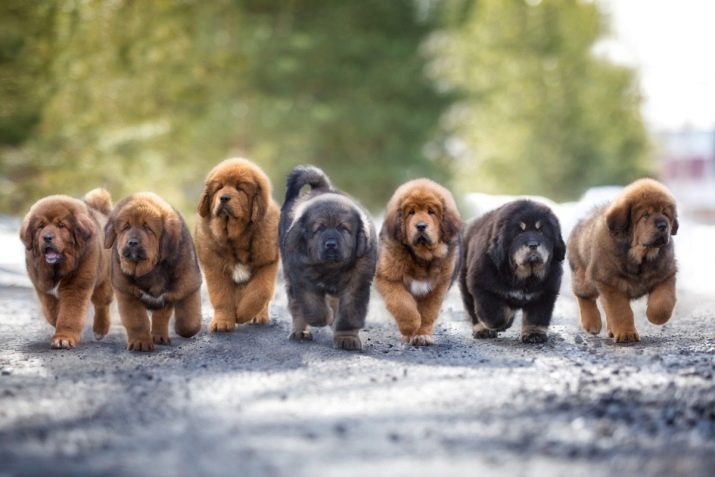
The table below shows the weight of Tibetan mastiff puppies by age.
Age | Body weight | Height at withers, cm |
Newborn | 0.4 to 0.6 | About 10 |
1 month | 3-5 | 24-28 |
2 months | 9-11 | 30-33 |
3 months | 15-19 | 40-50 |
4 months | 17-30 | 43-50 |
5 months | 24-40 | 50-60 |
6 months | 28-42 | 55-65 |
Seven months | 31-50 | 60-68 |
9 months | 45-55 | 62-70 |
1 year | 50-56 | 65-70 |
By the age of 1.5-2 years, the “Tibetan” practically reaches its final parameters, however, the development continues anyway: there is a set of muscle mass, bone growth, and puberty ends by two years.
Interesting facts about dogs, see below.





































